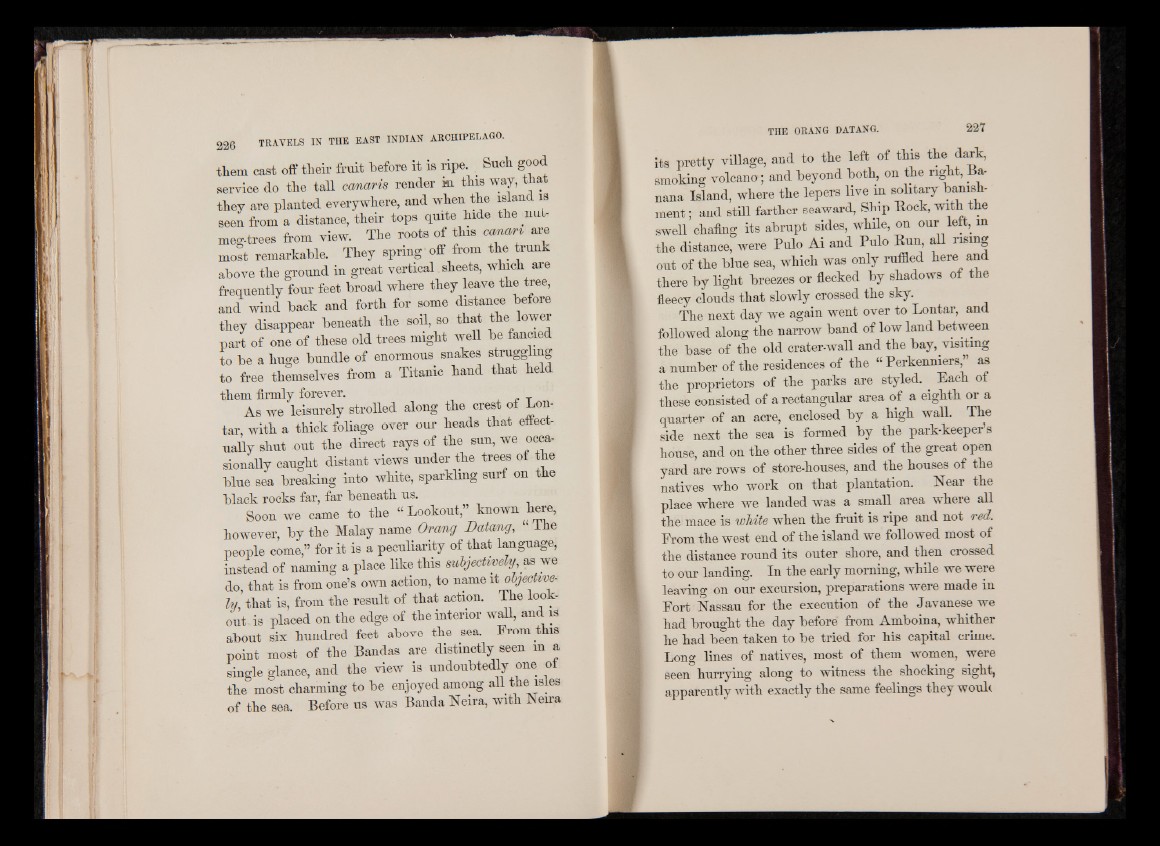
them cast off their fruit before it is ripe. Such good
service do the tall crnaris render in this way, that
they are planted everywhere, and when the island is
seen from a distance, their tops quite hide the nut-
meg-trees from view. The roots of this canar* are
most remarkable. They spring off from the trunk
above the ground in great vertical sheets, which are
frequently four feet broad where they leave the tree,
and wind back and forth for some distance before
they disappear beneath the soil, so that the lower
part of one of these old trees might well be fancied
to be a huge bundle of enormous snakes struggling
to free themselves from a Titanic hand that he
them firmly forever.
As we leisurely strobed along the crest of Lon-
tar with a thick foliage over our heads that effectually
shut out the direct rays of the sun, we occasionally
caught distant views under the trees of the
blue sea breaking into white, sparkling surf on the
black rocks far, far beneath us.
Soon we came to the “ Lookout,” known here,
however, by the Malay name Orang Datang, “ The
people come,” for it is a peculiarity of that language,
instead of naming a place like this subjectively, as we
do that is from one’s own action, to name it objectively
, that is, from the result of that action. The lookout
is placed on the edge of the interior wall, and is
about six hundred feet above the sea. From this
point most of the Bandas are distinctly seen m a
single glance, and the view is undoubtedly one ot
the most charming to be enjoyed among all the isles
of the sea. Before us was Banda Neira, with IS eira
its pretty village, and to the left of this the dark,
smoking volcano; and beyond both, on the right, Banana
Island, where the lepers live in solitary banishment
; and still farther seaward, Ship Bock, with the
swell chafing its abrupt sides, while, on o u r left, in
the distance, were Pulo Ai and Pulo Run, all nsing
out of the blue sea, which was only ruffled here and
there by light breezes or flecked by shadows of the
fleecy clouds that slowly crossed the sky.
The next day we again went over to Lontar, and
followed along the narrow band of low land between
the base of the old crater-wall and the bay, visiting
a number of the residences of the “ Perkenniers,” as
the proprietors of the parks are styled. Each of
these consisted of a rectangular area of a eighth or a
quarter of an acre, enclosed by a high walk The
side next the sea is formed by the park-keeper’s
house, and on the other three sides of the great open
yard are rows of store-houses, and the houses of the
natives who work on that plantation. Near the
place where we landed was a small area where all
the mace is white when the fruit is ripe and not red.
From the west end of the island we followed most of
the distance round its outer shore, and then crossed
to our landing. In the early morning, while we were
leaving on our excursion, preparations were made in
Fort Nassau for the execution of the Javanese we
had brought the day before from Amboina, whither
he had been taken to be tried for his capital crime.
Long lines of natives, most of them women, were
seen hurrying along to witness the shocking sight,
apparently with exactly the same feelings they wouk